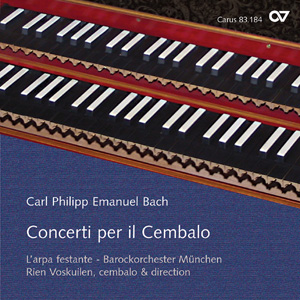
Concerti per il Cembalo
Contents
-
Composer
Carl Philipp Emanuel Bach
| 1714-1788Carl Philipp Emanuel Bach (1714–1788) was an extremely prolific composer who enjoyed a high reputation during his lifetime with the result that his music became known far and wide. The early works were influenced by the Berlin School. In his later works, however, this composer developed a thoroughly individual style, independent of contemporary fashions, which is to be found especially in the sacred vocal works written during his years as Director of Music in Hamburg (1768–1788). Personal details
-
Preface writer
Rien Voskuilen
-
Ensemble
L'arpa festante Barockorchester
-
Conductor
Rien Voskuilen
-
Soloist - harpsichord
Rien Voskuilen
Reviews
[...] Das mit 15 Streichern besetzte Orchester bemüht sich um einen reichen Klang jenseits erstarrter Alte-Musik-Klischees - und erreicht ihn auch. Besonders deutlich wird das in den Ecksätzen des c-Moll-Konzertes Wq 5/H. 407, welche einen schroffen, zerklüfteten Sturm-und-Drang-Gestus ausbilden: Zwischen den energischen Tutti und den leisen Passagen eröffnet sich eine aufregende Fallhöhe, ohne dass das Orchester auf Klangkultur und Tonschönheit verzichten müsste. Vielmehr ist der Streicherapparat geschlossen, ohne gekantet zu wirken, und in den langsamen Sätzen, besonders angenehm im Largo des G-Dur-Konzertes Wq 34/H. 444 und dem versonnenen Arioso des a-Moll-Konzertes Wq 26/H. 430, zu weichem, wenn auch kontrolliert geführtem Gesang fähig.
In allen Sätzen sind außerdem die Einwürfe in den Dialogpassagen zwischen Solo und Tutti einerseits mit soviel Formbewusstsein ausgestaltet, andererseits so variantenreich moduliert, dass sich eine sehr differenzierter Einheit herstellt, auch in den zeitlich ausgreifenden Kopfsätzen von Wq 34 und Wq 5. Solist und Leiter Rien Voskuilen lässt dabei stets so viel Zeit, dass die köstlichen Pizzicato-Effekte im Presto von Wq 34 und dem Allegro assai von Wq 5 so deutlich wie diskret herauskommen. Selbst aufnahmetechnisch ist das Cembalo (ein Nachbau eines flämischen Instrumentes von Dulcken aus dem Jahr 1745) so in den Vordergrund gerückt, dass es auch in den Ritornellen, wenn es gar nicht solo zu spielen hat, eine wichtige Rolle erfüllt, und nicht nur die Barock-Atmosphäre liefert; das trägt zum Bild einer sorgfältigen Produktion bei, bei der nur in der Track-Nummerierung ein kleiner Fehler passierte. Musikalisch jedoch sind das Lesarten, die sich wirklich auf die Musik einlassen und Carl Philipp Emanuel einen ungleich wertvolleren Dienst tun als alle vordergründige Effekthascherei.
Michael B. Weiß
Quelle: klassik-heute.de (07.11.2005)
[...] es gibt exzellente Ensemble, die sich gut vermarkten und ständig im Vordergrund stehen. Sie haben Verträge der großen Label und dann gibt es da noch Ensemble die sind genauso gut aber lugen immer so etwa aus der zweiten Reihe hervor. Als Beispiel heute das Münchner Ensemble "L'Arpa Festante"; den Fachleuten ein Begriff. Es hat jetzt beim Label Carus eine sehr feine CD mit Cembalo-Konzerten von Carl Philipp Emmanuel Bach eingespielt; am Cembalo der Leiter des Ensembles Rien Voskuilen: unsere CD des Tages. Sehr überlegt und bedeutungsvoll werden uns hier die musikalischen Gedanken vorgetragen. Das ganze ist sehr transparent und luftig-leicht gewebt, beeindruckendes Zusammenspiel.
Julika Jahnke
Quelle: MDR - Sendung "Figaro am Vormittag" (10.01.2006)
Beredt
(R.E.) [...] Mit viel Elan und Expression werden uns hier einige Konzerte vorgeführt, von denen eines besser als Orgelkonzert, ein anderes eher als Flötenkonzert bekannt ist. Obwohl das Cembalo nicht die Gestaltungskraft einer Flöte oder einer Orgel aufweist, bleiben diese Fassungen dem Hörer nichts schuldig. So beredt, wie Rien Voskuilen seinen Part umsetzt, so engagiert agieren die Münchner Instrumentalisten - mit zuweilen ein wenig ruppigem Ton.
Quelle: Fono Forum 02/06, S. 66
Today Carl Philipp Emanuel Bach is best known for his compositions for keyboard solo, and these are indeed the core of his oeuvre. But he also composed more than fifty concertos for keyboard and orchestra, more than anyone in music history. Considering their quality it is rather surprising they aren't often played on the concert platform. [...] The concertos on this disc are all for keyboard with strings and bass alone. That is the case with the first concerto on this disc, which dates from 1755 and which was originally composed for Princess Amalia, sister of Frederick the Great. She was an avid organist, and owned a house organ. Bach composed six sonatas for organ for the Princess, and it is also this instrument for which the solo part of this concerto was originally intended. Several copies of this concerto indicate the harpsichord as an alternative. [...] It is a delightful concerto and this recording shows that a performance with harpsichord works very well. The second concerto is one of the reworked pieces: the first version dates from 1739, the second - which is played here - from 1762. In this concerto Rien Voskuilen plays his own cadenzas, as Bach's cadenzas for this concerto are missing from the manuscript which is preserved in Brussels, and which has been used for the other concertos on this disc. The second movement of the last concerto - composed in 1750 - is striking because of its unusual lyricism. The expression in the style of the 'Empfindsamkeit' is absent, and it is also longer than usual: it is almost as long as the first movement, whereas in the other concertos the first movement is by far the longest. This concerto exists in no less than three versions: keyboard, transverse flute and cello. Rien Voskuilen and the orchestra L'arpa festante have grasped the character of these concertos extremely well. Voskuilen's performance is vigorous and sensitive. The orchestral playing is vital and the strong gestures in the tutti are realised very well.
Johan van Veen
Quelle: www.musicweb-international.com
Frequent questions about this work
 There are no questions and answers available so far or you were unable to find an answer to your specific question about this work? Then click here and send your specific questions to our Customer Services!
There are no questions and answers available so far or you were unable to find an answer to your specific question about this work? Then click here and send your specific questions to our Customer Services!


